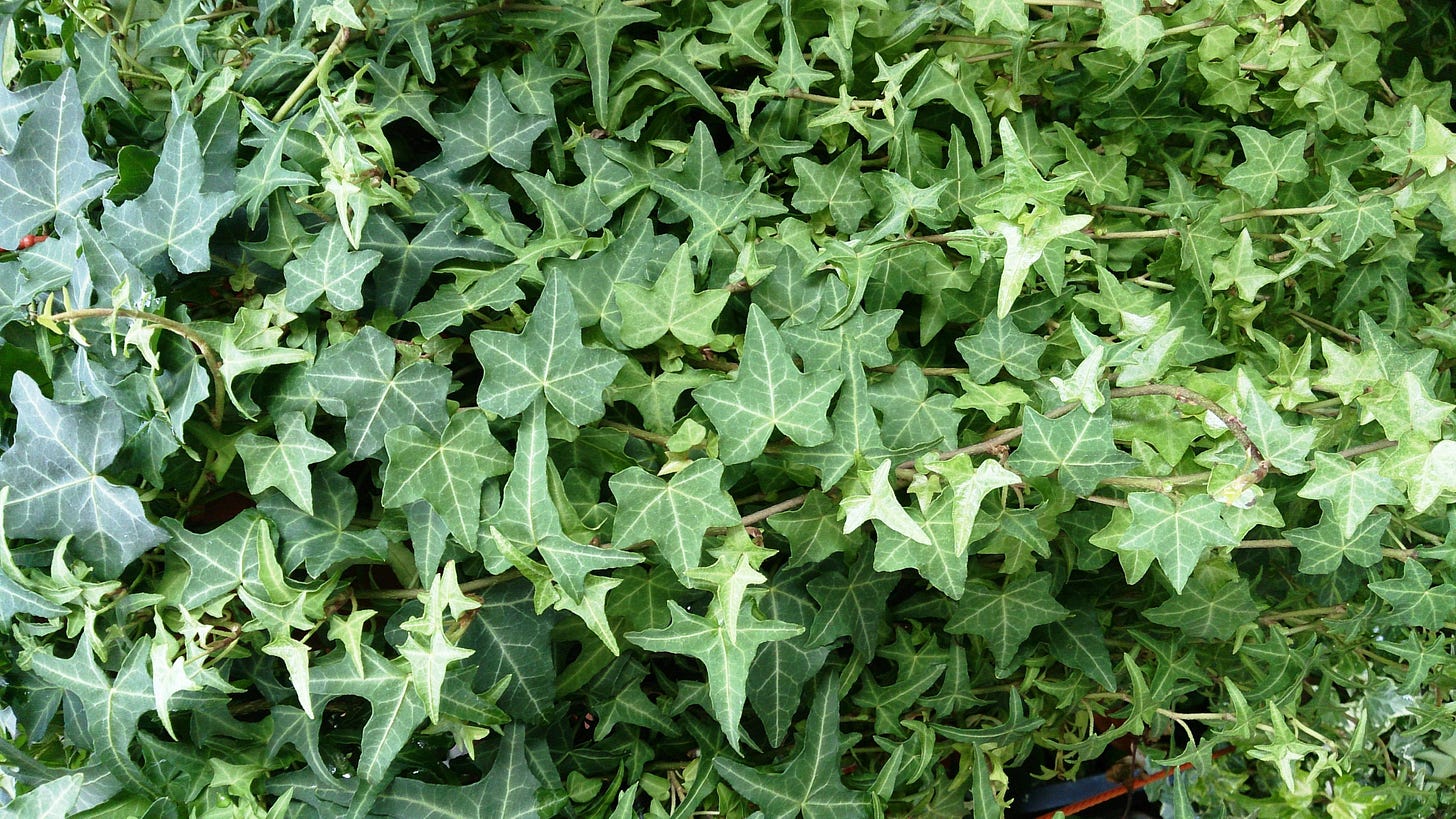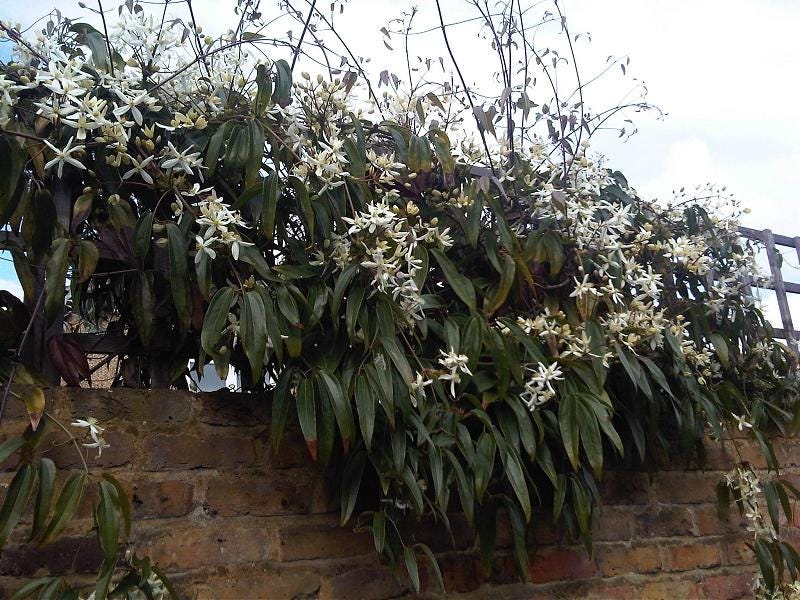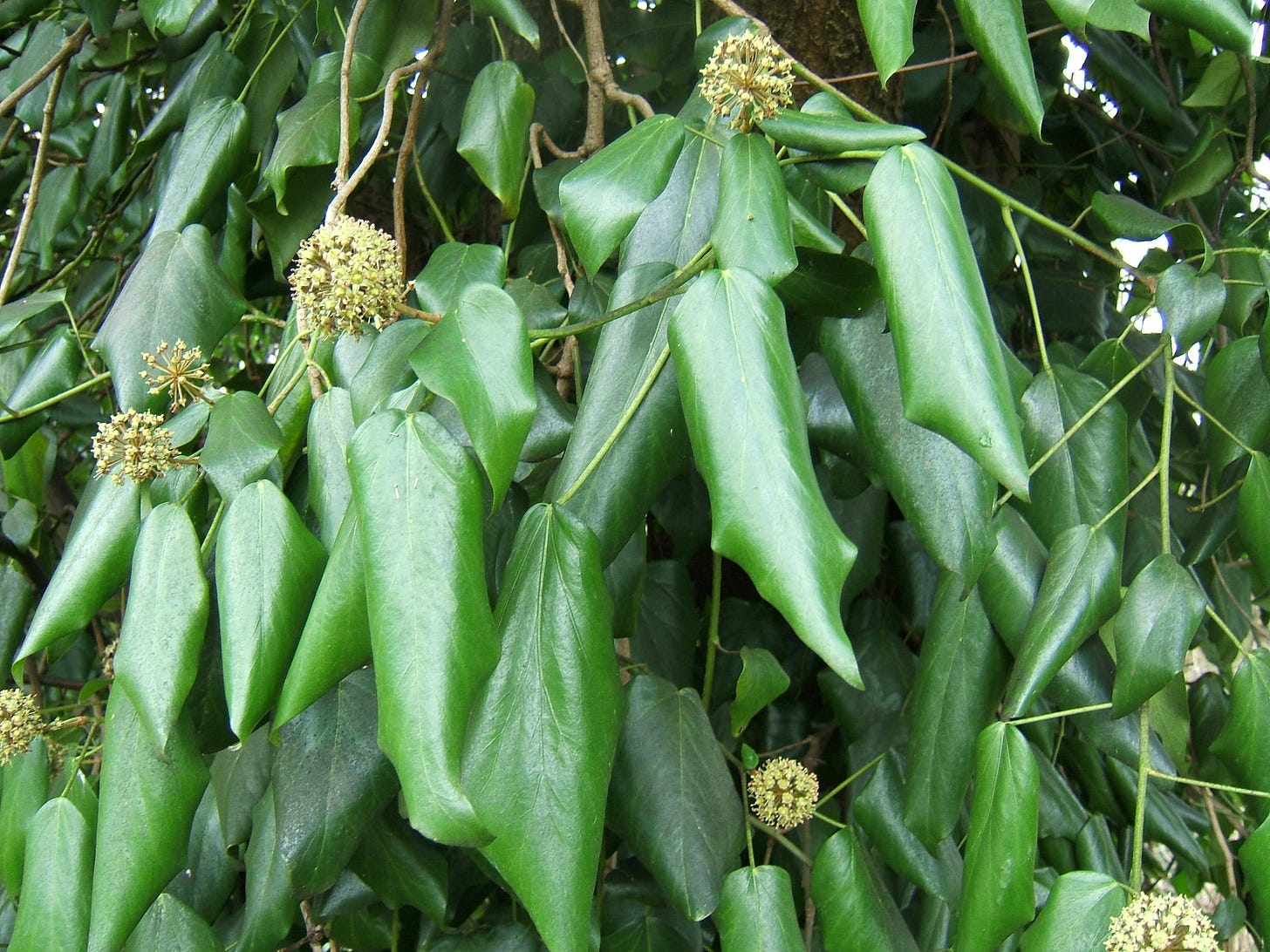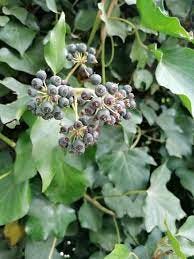ALSO KNOWN AS: Dentata Varie Gata, bullocks heart ivy, elephant’s ears, Persian ivy, sulfur heart
Not common ivy with its sturdy arrow shaped leaves
Not evergreen clematis. Though it has long leaves, the flowers don’t grow in umbells.
How to know:
A heart with waxy skin
Creamy white smudges
Rolled up sides like scrolls
A vine, yes, like ivy
Leaves that are 4-10” long!
On the outset there is nothing particularly interesting about an ivy. They are meant, it seems, to be invisible. They are only washes of green over a wall, to obscure or ornament. Our eyes flow over green, we drink the color in like thirsty travelers, it’s what we’ve evolved to do: love it completely. Because of our evolutionary tendency, immersion in green ivy can bring forth a deep and nostalgic feeling, a softness, connection, and liberation, as walls become living with leaves. Buildings come alive and magical. Ivy is so often associated with civilization, urbanness, class, and privilege. From the American ‘Ivy League’ it signifies academic excellence and athletics. The term ivy league comes from the elite group of eight US colleges whose tradition was the plant ivy on ‘ivy day’. Each year commemorates a different plant, which grow together along the sides of these institutions. They are evergreen plants with a promise of endless growth and expansion. ‘Ivy Day’ is still the famous day when college admissions decisions are released. It may be a remnant from the British ivy that covers their universities and their first founding in medieval Europe. .
The Herdera family is ivy: The beard of buildings. The urban mantle.
Tucked in the eastern coast of the Black Sea below the cascade of western Caucuses Northern Turkey, Iran, Azerbaijan, and Georgia host the largest ivy leaves in the world. They are so long they curl at the edges like small scrolls. The leathery evergreen leaves of Colchis ivy whorl in spirals along the stem. These leaves can range from a deep green to nearly purple shade. And they often have notable cream marks along the face.
The vines grow out on their own, far from their anchor in speckled woody vines. This is the most tree-like of ivies. It grows slowly, but can reach farther than the rest, at 10-15’ in five years and finally up to 50’ after 400. These leaves have been bred to either have teeth or remain smooth. Since this is a domesticated plant, there are a wide variety of variations. But there are only 12-15 species of ivy.
Colchis Ivy is in the Araliaceae family, related to ginseng and the rice paper plant, which until now, I did not know was not rice, but boasts large leaves and inflorescences like staghorn sumac or tree of heaven. These plants are commonly woody, vine-y, and have an umbel inflorescence structure.
Waving aerial rootlets look for places in which to nuzzle in building walls. Indeed buildings with ivy have a romantic air. And while ivy can degrade a building, many argue that the presence of ivy can create microclimates along the building’s edge. Depending on where on the building the plant is growing, the leaves protect the building from sun, wind, and even moderate temperature changes. According to the UK Royal Horticultural Society, the plants can even have a drying effect after rain if they grow on the south or east facing parts of the building. They can destroy north facing sides of buildings because they keep the water in.
Colchis ivy are known for their pronounced umbels. Umbels are a kind of inflorescence that look like a pom-pom, you can see them most obviously in milkweed. But these umbels are smaller and made of a dusting of green and white flowers that look like a miniature exploding firework. These make way for dark blue berries with five seeds in each (that look weirdly like acorns because they have little caps on them.) Like all ivies, the forest dwelling Colchis ivy seeds are spread by birds. And, of course, it’s leaves provide protection. Snails and slugs find shelter and breed in the thick foliage.
Colchis Ivy does potentially have medicinal elements that include antimicrobial, anti inflammatory, and antioxidant properties, it also has a high terpene content and can cause irritation and severe indigestion, so caution must be taken.
But as a structural plant, it has been used to mitigate flooding, with its thick and strong root system.
There are images of this ivy, green beneath a snow filled mountain pass. Like all ivy it flourishes in forests. Colchis ivy appreciates alkaline to neutral clay soils, surviving in various regions, which is why it grows in the space between the coast and the mountain. They like water in the air: humidity, whether that is salt water, or the cloud forests by streams and along mountain ranges. But they are hearty and can survive a range of conditions, because of this it can also behave aggressively if unchecked.
Clochis is a region in Georgia and well known as a peripheral but apparently powerful city of Greek mythology where Medea, priestess of Hecate and daughter of king Aeëtes helped Jason steal the golden fleece. The history of this region has been contested as it is a central point between massive powers from the Greeks to the Romans, the Islamic empire, the Byzantines, England, and Russia all laid claim to the land and its people.
But the actually history of Colchis is relatively inaccessible. The Milesian Greeks who traded with the Colchins saw this place as an important bastion for power. Here was where the Amazons were believed to live, where Prometheus was tied to a rock after giving humans fire. Colchis might have been the land just off the map to the Greek storytellers, and so it was unknown and full of beasts. The region is a temperate and fertile one, hugged by Caucasus all around and fed by their mineral streams. So it is no surprise that the bronze bulls of the Grecian legend lived there too. This ivy is also called the bullock’s heart: a large and strong heart.
Whether ivy is growing in Colchis or Boston, it seems that ivy has hitched itself to human civilization.
Climbing buildings like they are trees, growing in rough climates like they would near the summit of a mountain, all while they live they give us waves of green, cooling our eyes and calming our hearts.
Myth for Persian Ivy
There were people once who were incredibly adept at the craft of building. They lived in a kingdom overlooking the egg shaped sea. They were so proud of their works that they put their genius together to create a city that was so perfectly in tune with the environment. Ivy was their companion and it crept to the windows listening to every word that was ever said in this kingdom. It knew every language of those who made the buildings and linked itself close to their fate like a shadow, and so it hung along the walls and grew in the alleys of this perfect city. But the spirits of the sea came to believe that the people were mocking them, because they were the forgers of the land around the sea, and it was not for humans to build in this way.
The spirits brought winds and rains, destroying the structures that the people built. They rose from the ground in great mountains breaking the roads and temples to bits. The beauty that was left of these people’s work was nearly decimated and the people fled in all directions. The people promised to forget their craft.
But there was one who remembered, an architect. And instead of leaving she stayed, even though it broke her heart to see such destruction. And as she sat she found that everything became still. Even time stopped for her. And while all the world continued she sat, deciding what to do with her hands. And as she sat ivy began to grow. It grew from the mountains to the sea and it covered all of what was left of these people in a soft blanket.
You wonder who keeps the sleeper alive? See the ivy cover her like mist, waiting there, protecting her, until she wakes from her dreams.
That’s why when we see ivy, whisper your greatest wish, so it will send it back to the sleeper who may wake up and make your wish.
Forager Friendly?
Want to propagate this plant to make your own ivy wall? All you need is a clipping.
Forage it for food or medicine? Sure it’s been used for medicinal purposes, but for the layperson, no.
Sources:
https://www.missouribotanicalgarden.org/PlantFinder/PlantFinderDetails.aspx?taxonid=298893
https://www.youtube.com/watch?v=M7cIc7IAN6U
https://www.britannica.com/topic/Ivy-League
https://www.bowdoin.edu/about/history-traditions/index.html
https://archive.org/details/ivymonographcomp00hibb/page/104/mode/2up (page 105)
https://www.sciencedirect.com/science/article/abs/pii/S0360132310002222
https://www.britannica.com/topic/Medea-Greek-mythology
https://www.britannica.com/place/Colchis
https://www.sciencedirect.com/topics/immunology-and-microbiology/ivy
https://www.glasshouseworks.com/hedera-colchica-sulphur-heart








